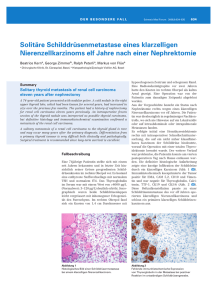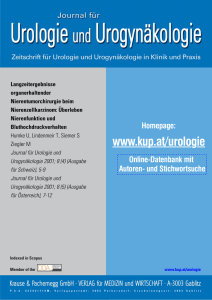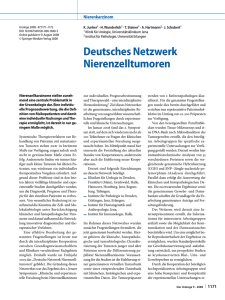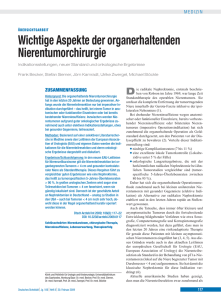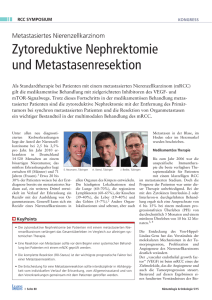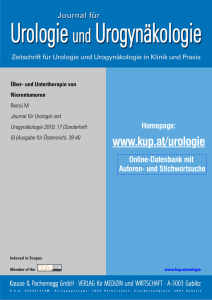Leitlinien Nierenzellkarzinom
Werbung
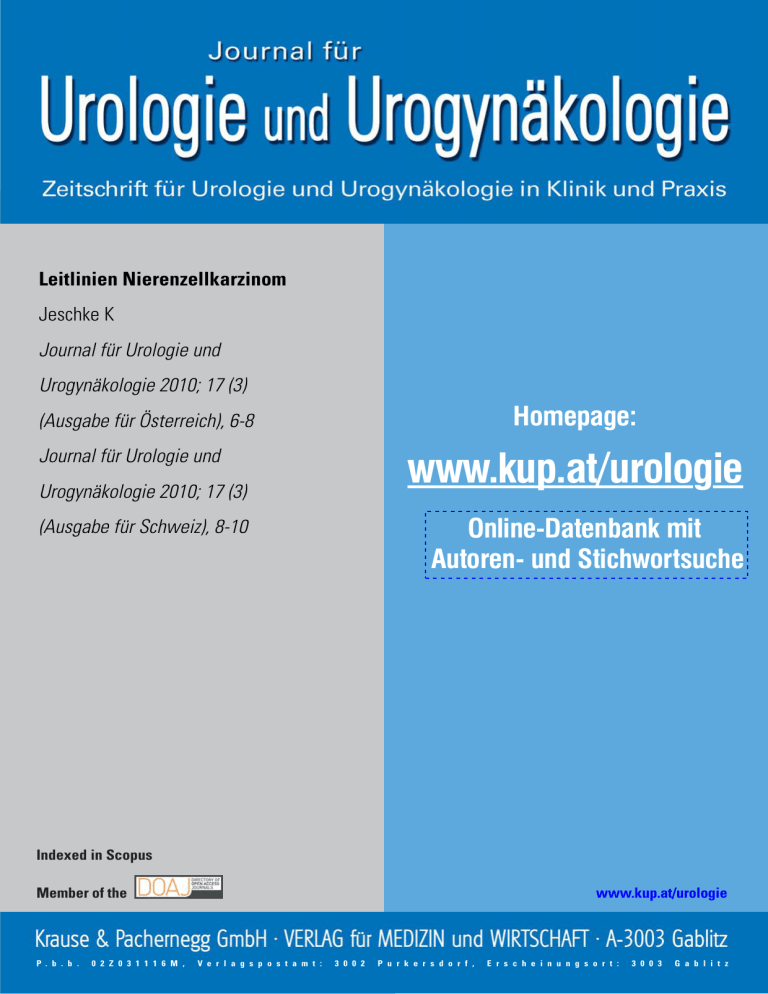
Leitlinien Nierenzellkarzinom Jeschke K Journal für Urologie und Urogynäkologie 2010; 17 (3) Homepage: (Ausgabe für Österreich), 6-8 www.kup.at/urologie Journal für Urologie und Urogynäkologie 2010; 17 (3) Online-Datenbank mit Autoren- und Stichwortsuche (Ausgabe für Schweiz), 8-10 Indexed in Scopus Member of the P . b . b . 0 2 Z 0 3 1 1 1 6 M , www.kup.at/urologie V e r l a g s p o s t a m t : 3 0 0 2 P u r k e r s d o r f , E r s c h e i n u n g s o r t : 3 0 0 3 G a b l i t z Leitlinien Nierenzellkarzinom Leitlinien Nierenzellkarzinom K. Jeschke Symptomatik Die Mehrzahl der Nierenzellkarzinome wird heute zufällig im Rahmen eines abdominellen Ultraschalls gefunden (EBM IV) [1]. Symptomatische Patienten mit klassischer Trias Flankenschmerz, Hämaturie und tastbarer Tumormasse finden sich nur noch in 6–10 % (EBM III) [2, 3]. Rund 30 % der symptomatischen Patienten weisen paraneoplastische Syndrome auf (u. a. Gewichtsverlust, Kachexie, Fieber, Abgeschlagenheit, hypochrome Anämie, Hyperkalziämie, abnorme Leberfunktion) (EBM IV) [1]. Bei 25–30 % der Patienten zeigen sich in Folge der Metastasierung Symptome wie Knochenschmerzen oder persistierender Husten (EBM IV) [1]. Basisdiagnostik Bei Verdacht auf ein Nierenzellkarzinom, also bei sonografisch positivem oder unklarem Befund oder bei Hämaturie mit sonografisch negativem Befund, ist eine Untersuchung mit Computertomographie (nach Möglichkeit Spiral-CT oder Multislice-CT) inklusive Kontrastmittel indiziert (EBM IV) [4]. Zur Lungenabklärung, Thorax-Röntgen als Minimum, bei suspektem Befund: Thorax-CT (EBM III) [5–12]. Die MRT bleibt Fällen vorbehalten, die in Sonographie und CT unklar bleiben, wie z. B. fragliche kleine Raumforderungen oder komplizierte Zysten oder Beteiligung der Vena cava (EBM III) [13–17]. Erweiterte Diagnostik Bei Cavathrombus MRT oder Doppler-Ultraschall (EBM III) [13–18]. Nur bei klinischen Verdachtsmomenten erweiterte Diagnostik mit Knochenszintigramm, Schädel-CT (EBM III) [19–20]; Nierenangiographie nur bei geplanter Teilresektion und komplizierter imperativer Indikation (EBM III) [21–23]. Der PET-CT hat keinen Stellenwert. Der Stellenwert der präoperativen Tumorbiopsie ist stark limitiert (EBM III) [21–23]. Therapie eine Lymphadenektomie sollte wegen des fehlenden therapeutischen Nutzens nur limitiert als Stagingverfahren durchgeführt werden (EBM IIb) [25–33]. Von den bekannten chirurgischen Zugängen ist derzeit keiner zu bevorzugen. Die laparoskopische Tumornephrektomie ist ein der offenen Operation gleichwertiges Verfahren für Patienten mit T1- bis 2-Renalzellkarzinomen bei gleichzeitig geringerer Morbidität (EBM III) [34–38]. Ihr sollte der Vorzug gegenüber der offenen Operation gegeben werden (Grad-B-Empfehlung). Bei Cava-Thrombus sind Lymphknoten und FernmetastasenPrognose bestimmend, die in dieser Situation doppelt so häufig sind. Fehlen sie, kann die Tumornephrektomie mit Cavotomie und kompletter Thrombektomie durchaus kurativ sein (EBM III) [39–42]. Organerhaltende Nierentumorchirurgie Imperative Indikationen für die Organerhaltung stellen anatomisch oder funktionelle Einzelnieren bzw. beidseitige Renalzellkarzinome dar. Relative Indikationen liegen bei Erkrankungen vor, die die Nierenfunktion im weiteren Verlauf beeinträchtigen könnten. Von elektiver Indikation spricht man bei gesunder kontralateraler Niere. Hier wird die Organerhaltung bei resektablen Tumoren < 4 cm empfohlen, da die onkologischen Ergebnisse ident zur Tumornephrektomie sind (EBM IIb) [43–45]. Die laparoskopische Nierentumorresektion ist nach wie vor kein Standardverfahren; sie sollte bei kleinen peripheren Tumoren Zentren mit laparoskopischer Erfahrung vorbehalten bleiben [46–49] (Grad-C-Empfehlung). Minimalinvasive Alternativen wie Radiofrequenzablation, Kryotherapie, HIFU und Mikrowelle müssen als experimentell gewertet werden. Sie sollten nur bei Patienten, die nicht OP-tauglich sind und kleine periphere Tumoren haben, zum Einsatz kommen (EBM III) [50–54] (Grad-B-Empfehlung). Bei metastasierendem Renalzellkarzinom wird die Tumornephrektomie vor systemischer Therapie empfohlen, da in Studien mit nachfolgender Interferon-alpha-Therapie ein Überlebensvorteil gezeigt werden konnte. Die Empfehlung gilt im Besonderen für Patienten mit gutem Performance-Status (EBM Ib) [55, 56] (Grad-A-Empfehlung). Chirurgische Therapie Beim lokalisierten Nierenzellkarzinom stellt die chirurgische Entfernung die einzige kurative Maßnahme dar. Tumornephrektomie Sie stellt dabei das operative Standardverfahren dar (EBM III) [24]. Die Adrenalektomie ist bei negativem Befund im CT und fehlendem direktem Tumorkontakt nicht erforderlich, 6 Metastasenchirurgie Eine komplette Metastasenresektion verbessert die klinische Prognose! Empfohlen wird sie bei synchroner Metastasierung, nach Ansprechen der Metastasen auf Zytokintherapie, aber auch bei einer oder einzelnen Metachromen-Metastasen. Die komplette Resektabilität ist dabei Voraussetzung (EBM III) [56–60] (Grad-B-Empfehlung)! J UROL UROGYNÄKOL 2010; 17 (3) For personal use only. Not to be reproduced without permission of Krause & Pachernegg GmbH. Leitlinien Nierenzellkarzinom Strahlentherapie bei Metastasen Bei Hirn- und Knochenmetastasen kann die Strahlentherapie die Symptomatik bessern (EBM IIb) [61–64] (Grad-B-Empfehlung). Makrohämaturie in der Palliativsituation Tumorembolisierung (EBM III) [65–71] Adjuvante Therapie Derzeit gibt es keine etablierte adjuvante Therapie nach erfolgreicher Operation des Primärtumors. Gleiches gilt für eine neoadjuvante Therapie. Beide sollten daher nur im Rahmen klinischer Studien erfolgen (EBM Ib) [72–76] (Grad-A-Empfehlung). Literatur: 1. Novick AC, Campbell SC. Renal tumours. In: Walsh PC, Retik, AB, Vaughan ED, Wein AJ, (eds). Campbell’s Urology. WB Saunders, Philadelphia, 2002; 2672–731. 2. Lee CT, Katz J, Fearn PA, Russo P. Mode of presentation of renal cell carcinoma provides prognostic information. Urol Oncol 2002; 7: 135–40. 3. Patard JJ, Leray E, Rodriguez A, RiouxLeclercq N, Guille F, Lobel B. Correlation between symptom graduation, tumor characteristics and survival in renal cell carcinoma. Eur Urol 2003; 44: 226–32. 4. Bechtold RE, Zagoria RJ. Imaging approach to staging of renal cell carcinoma. Urol Clin North Am 1997; 24: 507–22. 5. Heidenreich A, Ravery V; European Society of Oncological Urology. Preoperative imaging in renal cell cancer. World J Urol 2004; 22: 307–15. 6. Sheth S, Scatarige JC, Horton KM, Corl FM, Fishman EK. Current concepts in the diagnosis and management of renal cell carcinoma: role of multidetector CT and threedimensional CT. Radiographics 2001; 21: S237–S254. 7. Miles KA, London NJ, Lavelle JM, Messios N, Smart JG. CT staging of renal carcinoma: a prospective comparison of three dynamic computed tomography techniques. Eur J Radiol 1991; 13: 37–42. 8. Lim DJ, Carter MF. Computerized tomography in the preoperative staging for pulmonary metastases in patients with renal cell carcinoma. J Urol 1993; 150: 1112–4. 9. Doda SS, Mathur RK, Buxi TS. Role of computed tomography in staging of renal cell carcinoma. Comput Radiol 1986; 10: 183–8. 10. Fritzsche PJ, Millar C. Multimodality approach to staging renal cell carcinoma. Urol Radiol 1992; 14: 3–7. 11. McClennan BL, Deyoe LA. The imaging evaluation of renal cell carcinoma: diagnosis and staging. Radiol Clin North Am 1994; 32: 55–69. 12. Tammela TL, Leinonen AS, Kontturi MJ. Comparison of excretory urography, angiography, ultrasound and computed tomography for T category staging of renal cell carcinoma. Scand J Urol Nephrol 1991; 25: 283– 6. 13. Hricak H, Demas BE, Williams RD, McNamara MT, Hedgcock MW, Amparo EG, Tanagho EA. Magnetic resonance imaging in the diagnosis and staging of renal and perirenal neoplasms. Radiology 1985; 154: 709– 15. 14. Janus CL, Mendelson DS. Comparison of MRI and CT for study of renal and perirenal masses. Crit Rev Diagn Imaging 1991; 32: 69–118. 15. Krestin GP, Gross-Fengels W, Marincek B. [The importance of magnetic resonance tomography in the diagnosis and staging of renal cell carcinoma.] Radiologe 1992; 32: 121–6. [German] 16. Nishimura K, Hida S, Okada K, Yoshida O, Nishimuara K. Staging and differential diagnosis of renal cell carcinoma: a comparison of magnetic resonance imaging (MRI) and computed tomography (CT). Hinyokika Kiyo 1988; 34: 1323–31. 17. Kabala JE, Gillatt DA, Persad RA, Penry JB, Gingell JC, Chadwick D. Magnetic resonance imaging in the staging of renal cell carcinoma. Br J Radiol 1991; 64: 683–9. 18. Gupta NP, Ansari MS, Khaitan A, Sivaramakrishna MS, Hemal AK, Dogra PN, Seth A. Impact of imaging and thrombus level in management of renal cell carcinoma extending to veins. Urol Int 2004; 72: 129– 34. 19. Hendriksson C, Haraldsson G, Aldenborg F, Lindberg S, Pettersson S. Skeletal metastases in 102 patients evaluated before surgery for renal cell carcinoma. Scand J Urol Nephrol 1992; 26: 363–6. 20. Marshall ME, Pearson T, Simpson W, Butler K, McRoberts W. Low incidence of asymptomatic brain metastases in patients with renal cell carcinoma. Urology 1990; 36: 300–2. 21. Seaman E, Goluboff ET, Ross S, Sawczuk IS. Association of radionuclide bone scan and serum alkaline phosphatase in patients with metastatic renal cell carcinoma. Urol 1996; 48: 692–5. 22. Brierly RD, Thomas PJ, Harrison NW, Fletcher MS, Nawrocki JD, Ashton-Key M. Evaluation of fineneedle aspiration cytology for renal masses. BJU Int 2000; 85: 14–8. 23. Dechet CB, Zincke H, Sebo TJ, King BF, LeRoy AJ, Farrow GM, Blute ML. Prospective analysis of computerized tomography and needle biopsy with permanent sectioning to determine the nature of solid renal masses in adults. J Urol 2003; 169: 71–4. 24. Robson CJ, Churchill BM, Anderson W. The results of radical nephrectomy for renal cell carcinoma. J Urol 1969; 101: 297–301. 25. Angervall L, Wahlqvist L. Follow-up and prognosis of renal carcinoma in a series operated by perifascial nephrectomy combined with adrenalectomy and retroperitoneal lymphadenectomy. Eur Urol 1978; 4: 13–7. 26. Kozak W, Holtl W, Pummer K, Maier U, Jeschke K, Bucher A. Adrenalectomy-still a must in radical renal surgery? Br J Urol 1996; 77: 27–31. provides meaningful long-term survival. Ann Surg 1989; 210: 387–92; discussion 392–4. 27. Kuczyk M, Munch T, Machtens S, Bokemeyer C, Wefer A, Hartmann J, Kollmannsberger C, Kondo M, Jonas U. The need for routine adrenalectomy during surgical treatment for renal cell cancer: the Hannover experience. BJU Int 2002; 89: 517–22. 43. Lee CT, Katz J, Shi W, Thaler HT, Reuter VE, Russo P. Surgical management of renal tumors 4 cm or less in a contemporary cohort. J Urol 2000; 163: 730–6. 28. Kuczyk M, Wegener G, Jonas U. The therapeutic value of adrenalectomy in case of solitary metastatic spread originating from primary renal cell cancer. Eur Urol 2005; 48: 252–7. 29. Sandock DS, Seftel AD, Resnick MI. Adrenal metastases from renal cell carcinoma: role of ipsilateral adrenalectomy and definition of stage. Urology 1997; 49: 28– 31. 30. Li GR, Soulie M, Escourrou G, Plante P, Pontonnier F. Micrometastatic adrenal invasion by renal carcinoma in patients undergoing nephrectomy. Br J Urol 1996; 78: 826–8. 31. Leibovitch I, Raviv G, Mor Y, Nativ O, Goldwasser B. Reconsidering the necessity of ipsilateral adrenalectomy during radical nephrectomy for renal cell carcinoma. Urology 1995; 46: 316–20. 44. Uzzo RG, Novick AC. Nephron-sparing surgery for renal tumors: indications, techniques and outcomes. J Urol 2001; 166: 6– 18. 45. Delakas D, Karyotis I, Daskalopoulos G, Terhorst B, Lymberopoulos S, Cranidis A. Nephron-sparing surgery for localized renal cell carcinoma with a normal contralateral kidney: a European three-center experience. Urology 2002; 60: 998–1002. 46. Link RE, Bhayani SB, Allaf ME, Varkarakis I, Inagaki T, Rogers C, Su LM, Jarrett TW, Kavoussi LR. Exploring the learning curve, pathological outcomes and perioperative morbidity of laparoscopic partial nephrectomy performed for renal mass. J Urol 2005; 173: 1690–4. 47. Novick AC. Laparoscopic and partial nephrectomy. Clin Cancer Res 2004; 10: 6322S–6327S. 32. von Knobloch R, Seseke F, Riedmiller H, Grone HJ, Walthers EM, Kalble T. Radical nephrectomy for renal cell carcinoma: is adrenalectomy necessary? Eur Urol 1999; 36: 303–8. 48. Porpiglia F, Fiori C, Terrone C, Bollito E, Fontana D, Scarpa RM. Assessment of surgical margins in renal cell carcinoma after nephron sparing: a comparative study: laparoscopy vs open surgery. J Urol 2005; 173: 1098–101. 33. Zisman A, Wieder JA, Pantuck AJ, Chao DH, Dorey F, Said JW, Gitlitz BJ, deKernion JB, Figlin RA, Belldegrun AS. Renal cell carcinoma with tumor thrombus extension: biology, role of nephrectomy and response to immunotherapy. J Urol 2003; 169: 909–16. 49. Matin SF, Gill IS, Worley S, Novick AC. Outcome of laparoscopic radical and open partial nephrectomy for the sporadic 4 cm or less renal tumor with a normal contralateral kidney. J Urol 2002; 168: 1356–9; discussion 1359–60. 34. Desai MM, Strzempkowski B, Matin SF, Steinberg AP, Ng C, Meraney AM, Kaouk JH, Gill IS. Prospective randomized comparison of transperitoneal versus retroperitoneal laparoscopic radical nephrectomy. J Urol 2005; 173: 38–41. 50. Lui KW, Gervais DA, Mueller PR. Radiofrequency ablation: an alternative treatment method of renal cell carcinoma. Chang Gung Med J 2004; 27: 618–23. 35. Ono Y, Hattori R, Gotoh M, Yoshino Y, Yoshikawa Y, Kamihira O. Laparoscopic radical nephrectomy for renal cell carcinoma: the standard of care already? Curr Opin Urol 2005; 15: 75–8. 36. Rassweiler J, Tsivian A, Kumar AV, Lymberakis C, Schulze M, Seeman O, Frede T. Oncological safety of laparoscopic surgery for urological malignancy: experience with more than 1,000 operations. J Urol 2003; 169: 2072–5. 37. Makhoul B, De La Taille A, Vordos D, Salomon L, Sebe P, Audet JF, Ruiz L, Hoznek A, Antiphon P, Cicco A, Yiou R, Chopin D, Abbou CC. Laparoscopic radical nephrectomy for T1 renal cancer: the gold standard? A comparison of laparoscopic vs open nephrectomy. BJU Int 2004; 93: 67–70. 38. Wille AH, Roigas J, Deger S, Tullmann M, Turk I, Loening SA. Laparoscopic radical nephrectomy: techniques, results and oncological outcome in 125 consecutive cases. Eur Urol 2004; 45: 483–8; discussion 488–9. 39. Bissada NK, Yakout HH, Babanouri A, Elsalamony T, Fahmy W, Gunham M, Hull GW, Chaudhary UB. Long-term experience with management of renal cell carcinoma involving the inferior vena cava. Urology 2003; 61: 89–92. 40. Giberti C, Oneto F, Martorana G, Rovida S, Carmignani G. Radical nephrectomy for renal cell carcinoma: long-term results and prognostic factors on a series of 328 cases. Eur Urol 1997; 31: 40–8. 41. Glazer AA, Novick AC. Long-term followup after surgical treatment for renal cell carcinoma extending into the right atrium. J Urol 1996; 155: 448–50. 42. Skinner DG, Pritchett TR, Lieskovsky G, Boyd SD, Stiles QR. Vena caval involvement by renal cell carcinoma. Surgical resection 51. Lewin JS, Nour SG, Connell CF, Sulman A, Duerk JL, Resnick MI, Haaga JR. Phase II clinical trial of interactive MR imaging-guided interstitial radiofrequency thermal ablation of primary kidney tumors: initial experience. Radiology 2004; 232: 835–45. 52. Gill IS, Remer EM, Hasan WA, Strzempkowski B, Spaliviero M, Steinberg AP, Kaouk JH, Desai MM, Novick AC. Renal cryoablation: outcome at 3 years. J Urol 2005; 173: 1903–7. 54. Lin CH, Moinzadeh A, Ramani AP, Gill IS. Histopathologic confirmation of complete cancer-cell kill in excised specimens after renal cryotherapy. Urology 2004; 64: 590. 54. Hines-Peralta A, Goldberg SN. Review of radiofrequency ablation for renal cell carcinoma. Clin Cancer Res 2004; 10: 6328S– 6334S. 55. Flanigan RC, Mickisch G, Sylvester R, Tangen C, Van Poppel H, Crawford ED. Cytoreductive nephrectomy in patients with metastatic renal cancer: a combined analysis. J Urol 2004; 171: 1071–6. 56. Ljungberg B, Landberg G, Alamdari FI. Factors of importance for prediction of survival in patients with metastatic renal cell carcinoma, treated with or without nephrectomy. Scand J Urol Nephrol 2000; 34: 246– 51. 57. Pongracz N, Zimmerman R, Kotz R. Orthopaedic management of bony metastases of renal cancer. Semin Surg Oncol 1988; 4: 139–42. 58. Tongaonkar HB, Kulkarni JN, Kamat MR. Solitary metastases from renal cell carcinoma: a review. J Surg Oncol 1992; 49: 45– 8. 59. van der Poel HG, Roukema JA, Horenblas S, van Geel AN, Debruyne FM. Metastasectomy in renal cell carcinoma: a multicenter retrospective analysis. Eur Urol 1999; 35: 197–203. J UROL UROGYNÄKOL 2010; 17 (3) 7 Leitlinien Nierenzellkarzinom 60. Jackson RJ, Loh SC, Gokaslan ZL. Metastatic renal cell carcinoma of the spine: surgical treatment and results. J Neurosurg 2001; 94: 18–24. 61. Fossa SD, Kjolseth I, Lund G. Radiotherapy of metastases from renal cancer. Eur Urol 1982; 8: 340–2. 62. Gez E, Libes M, Bar-Deroma R, Rubinov R, Stein M, Kuten A. Postoperative irradiation in localized renal cell carcinoma: the Rambam Medical Center experience. Tumori 2002; 88: 500–2. 63. Andrews DW, Scott CB, Sperduto PW, Flanders AE, Gaspar LE, Schell MC, WernerWasik M, Demas W, Ryj J, Bahary JP, Souhami L, Rotman M, Mehta MP, Curran WJ Jr. Whole brain radiation therapy with or without stereotactic radiosurgery boost for patients with one to three brain metastases: phase III results of the RTOG 9508 randomised trial. Lancet 2004; 363: 1665– 72. 64. Kavolius JP, Mastorakos DP, Pavlovich C, Russo P, Burt ME, Brady MS. Resection of metastatic renal cell carcinoma. J Clin Oncol 1998; 16: 2261–6. 65. Bakal CW, Cynamon J, Lakritz PS, Sprayregen S. Value of preoperative renal artery embolization in reducing blood transfusion requirements during nephrectomy for renal cell carcinoma. J Vasc Interv Radiol 1993; 4: 727–31. 8 J UROL UROGYNÄKOL 2010; 17 (3) 66. Hemingway AP, Allison DJ. Complications of embolization: analysis of 410 procedures. Radiology 1988; 166: 669–72. 67. Lanigan D, Jurriaans E, Hammonds JC, Wells IP, Choa RG. The current status of embolization in renal cell carcinoma – a survey of local and national practice. Clin Radiol 1992; 46: 176–8. 68. Munro NP, Woodhams S, Nawrocki JD, Fletcher MS, Thomas PJ. The role of transarterial embolization in the treatment of renal cell carcinoma. BJU Int 2003; 92: 240–4. 69. Onishi T, Oishi Y, Suzuki Y, Asano K. Prognostic evaluation of transcatheter arterial embolization for unresectable renal cell carcinoma with distant metastasis. BJU Int 2001; 87: 312–5. 70. Zielinski H, Szmigielski S, Petrovich Z. Comparison of preoperative embolization followed by radical nephrectomy with radical nephrectomy alone for renal cell carcinoma. Am J Clin Oncol 2000; 23: 6–12. 71. O’Brien WM, Lynch JH. Adrenal metastases by renal cell carcinoma. Incidence at nephrectomy. Urology 1987; 29: 605–7. 72. Galligioni E, Quaia M, Merlo A, Carbone A, Spada A, Favaro D, Santarossa M, Sacco C, Talamini R. Adjuvant immunotherapy treatment of renal carcinoma patients with autologous tumor cells and bacillus Calmette-Guerin: five-year results of a prospective randomized study. Cancer 1996; 77: 2560–6. 73. Figlin RA, Thompson JA, Bukowski RM, Vogelzang NJ, Novick AC, Lange P, Steinberg GD, Belldegrun AS. Multicenter, randomized, phase III trial of CD8(+) tumorinfiltrating lymphocytes in combination with recombinant interleukin-2 in metastatic renal cell carcinoma. J Clin Oncol 1999; 17: 2521–9. 74. Clark JI, Atkins MB, Urba WJ, Creech S, Figlin RA, Dutcher JP, Flaherty L, Sosman JA, Logan TF, White R, Weiss GR, Redman BG, Tretter CP, McDermott D, Smith JW, Gordon MS, Margolin KA. Adjuvant highdose bolus interleukin-2 for patients with high-risk renal cell carcinoma: a cytokine working group randomized trial. J Clin Oncol 2003; 21: 3133–40. 75. Atzpodien J, Schmitt E, Gertenbach U, Fornara P, Heynemann H, Maskow A, Ecke M, Woltjen HH, Jentsch H, Wieland W, Wandert T, Reitz M; German Cooperative Renal Carcinoma Chemo-Immunotherapy Trials Group (DGCIN). Adjuvant treatment with interleukin-2- and interferon-alpha2a-based chemoimmunotherapy in renal cell carcinoma post tumour nephrectomy: results of a prospectively randomised trial of the German Cooperative Renal Carcinoma Chemoimmunotherapy Group (DGCIN). Br J Cancer 2005; 92: 843–6. 76. Jocham D, Richter A, Hoffmann L, Iwig K, Fahlenkamp D, Zakrzewski G, Schmitt E, Dannenberg T, Lehmacher W, von Wietersheim J, Doehn C. Adjuvant autologous renal tumour cell vaccine and risk of tumour progression in patients with renal-cell carcinoma after radical nephrectomy: phase III, randomised controlled trial. Lancet 2004; 363: 594–9. Korrespondenzadresse: Prim. Dr. Klaus Jeschke Urologische Abteilung, LKH Klagenfurt A-9020 Klagenfurt, St.-Veiter-Straße 34 E-Mail: [email protected] Mitteilungen aus der Redaktion Besuchen Sie unsere zeitschriftenübergreifende Datenbank Bilddatenbank Artikeldatenbank Fallberichte e-Journal-Abo Beziehen Sie die elektronischen Ausgaben dieser Zeitschrift hier. Die Lieferung umfasst 4–5 Ausgaben pro Jahr zzgl. allfälliger Sonderhefte. Unsere e-Journale stehen als PDF-Datei zur Verfügung und sind auf den meisten der markt­ üblichen e-Book-Readern, Tablets sowie auf iPad funktionsfähig. Bestellung e-Journal-Abo Haftungsausschluss Die in unseren Webseiten publizierten Informationen richten sich ausschließlich an geprüfte und autorisierte medizinische Berufsgruppen und entbinden nicht von der ärztlichen Sorgfaltspflicht sowie von einer ausführlichen Patientenaufklärung über therapeutische Optionen und deren Wirkungen bzw. Nebenwirkungen. Die entsprechenden Angaben werden von den Autoren mit der größten Sorgfalt recherchiert und zusammengestellt. Die angegebenen Dosierungen sind im Einzelfall anhand der Fachinformationen zu überprüfen. Weder die Autoren, noch die tragenden Gesellschaften noch der Verlag übernehmen irgendwelche Haftungsansprüche. Bitte beachten Sie auch diese Seiten: Impressum Disclaimers & Copyright Datenschutzerklärung
